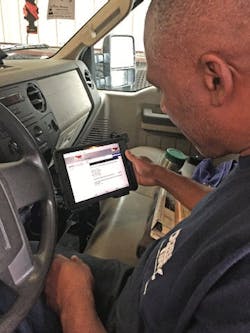Dorsey Tire Equips its Roadside Service Techs with Mobile Technology
The latest technology at Dorsey Tire Co. Inc. improves the speed and accuracy of emergency roadside service calls. And it’s in the hands, or more accurately, in the Apple iPad Air 2 screen tablets, of 25 service technicians.
It took years for Bruce Chamblee to find the cost-effective mobile-friendly application that allows his technicians to electronically complete and submit documents from the scene of an emergency roadside service call. Chamblee, who is a managing partner and general manager at Dorsey Tire, found the technology he wanted in April 2015.
To be exact, he found it in two places: MaddenCo Inc. and the Bridgestone Bandag Tire Solutions division of Bridgestone Americas Inc.
Based in Pooler, Ga., Dorsey Tire operates commercial stores in Pooler and Darien, Ga. The Darien store also does a small amount of retail sales and service. In addition, Dorsey offers truck tire retreading, trailer maintenance, tank maintenance, truck maintenance and parts sales. Tire sales and service make up more than 60% of Dorsey Tire’s business.
First steps to mobility
Dorsey Tire actually took its first steps to the mobility app for roadside calls at the end of 2013. In that year the company began using the accounting software module of MaddenCo’s Tire Dealer System. Chamblee, however, was impatient for more. He had come to Dorsey Tire in 2005 from Coca-Cola Co., which had implemented mobile technology for tracking products and processing orders in the late 1990s.
The retreading operation was the only part of Dorsey Tire using mobile technology when Chamblee came on board. The Bridgestone BASys system for tire management had some mobility features for tracking and asset management at that time. There was little automation in the rest of Dorsey Tire’s operation.
“When I came to the business, there was a lot of paper handling and a lot of requirements that customers put on dealers to capture certain data points when we were servicing their equipment. The path of data and communication between the fleet to the dealer to the technician to the driver and back was very cumbersome.
“So back in the late 2000s, I started looking for mobility and was researching what it would cost for us to develop our own. And the cost was way too much. The desire was there and the technology was there, but it was not cost effective to do it.”
From dream to reality
It would take a decade and a half for the technology to become economical. In July 2014 MaddenCo unveiled a fleet service app and a delivery service app. Chamblee immediately adopted both apps. The fleet service app is used by technicians responding to after-hours calls. “They use it to obtain pricing for cash customers, verify credit and check inventory levels for after-hours calls.”
Before the fleet app, a tech would physically go to a store to check the availability of a tire. There’s no need now. “The technician opens the app, looks at the available inventory in the store and tells the caller we have that tire in the store and here’s your price.”
Then more good news arrived. “In December 2014 I learned MaddenCo was going to come out with a service mobility app. To me it felt like Christmas was coming,” says Chamblee.
But the time to adopt the app, called MCIService app, was not right yet. “In April 2015, I attended a conference for Bridgestone dealers that use the company’s BASys manufacturing system for retread shops. At the conference, Bridgestone came out with their mobility piece, an iPad app for mobile work order entry.”
“I had to have certain things in place to trigger my launch,” says Chamblee. “Before the Bridgestone conference I was thinking I would give the techs smart phones. We would have the new MaddenCo service app on it and the techs would be able to make phone calls and get emails. Then I saw I could put the BASys work order entry piece on an iPad. It kept me from putting a smart phone in everyone’s hand.”
At the same time, Chamblee learned about mobile device management software which allows an organization to monitor and secure mobile devices used by its employees. Now he was ready. “When I learned about all this in April, I put together how to launch and manage the iPads for both the BASys and MaddenCo services. The immediate fear was I would I give an iPad to a tech and have no control over what’s going on with it. The mobile device management technology gave me the ability to control my assets, which made my CFO extremely happy.”
In June 2015, Chamblee began deploying 25 iPads to replace the handheld Motorola brand devices his techs were using. Twenty-two iPads are assigned to service techs and three to pick-up and delivery drivers. The first to receive iPads were the in-shop service techs. “We did drive-in service first; that way we could control it. If a tech ran into an issue, it’s a walk in the office rather than making a phone call from the side of the road.” Following the smooth launch, Chamblee assigned an iPad to each of his 20 road service techs. Each of his three pick-up and delivery drivers then got their iPads. By the middle of July, the launch was complete. How is it working to date? “It has been a dream,” says Chamblee.
An affordable investment
The company’s investment in the app and iPads is around $15,000. “An iPad, from an investment standpoint, is quite affordable,” says Chamblee. “I wasn’t exactly sure how I would roll out an app from MaddenCo. Then Bandag announced they had come up with the BASys work order piece. Just to write up tires under the old way was going to cost me anywhere from $2,000 to $4,000 per handheld with no cellular capability. I’m able to implement an iPad for a tenth of the cost of a handheld and have cellular capability. Now I have something that not only can do my service piece for MaddenCo but can also do my BASys work order entry, plus print, email and have GPS capability to route my tech to a site.”
The MCIService app’s capabilities include transmitting customer requests for emergency roadside assistance to service technicians and tracking a technician’s status in real time. The app also allows techs to take photos of the services provided and attach the photos to the invoice, complete customer-specific inspection forms, and capture the customer’s signature and attach it to the invoice.
For all its capabilities, the app could not generate a paper receipt. Dorsey Tire came up with a solution. “We would get one-offs where a cash customer wants a receipt. At that point we had to figure out a way of printing from the iPad. We got HP100 printers and found a wireless controller that we could mount on the printer. The iPad is tethered to the printer.”
The MCIService app has improved the speed, accuracy and efficiency of communications and administrative functions throughout Dorsey Tire. For example, the company now notifies techs of program changes for fleets by email rather than pulling them into the office for a meeting.
The service app’s real advantage is the opportunity it creates to do more business. Before the app was adopted, a tech who completed a service call hand wrote a ticket, brought it to the office and gave it to someone who keyed the data into the accounting system to generate a bill or purchase order. “Now, I’m paying for a technician to generate a ticket that is being keyed in on an iPad. All the data is on it; it’s done,” says Chamblee. The time office personnel take to review the work order before it becomes an invoice is minimal. “Our office people are also counter people and dispatchers. If they don’t have to bang on paperwork, they are at the counter servicing customers, calling customers, helping customers. We’re giving better customer service.” ■
About the Author

Ann Neal
Ann Neal is a former senior editor at Modern Tire Dealer.
